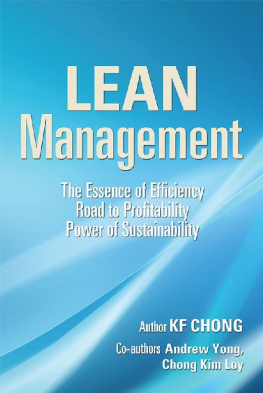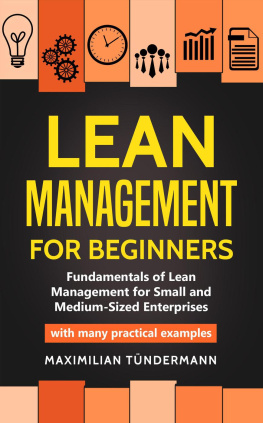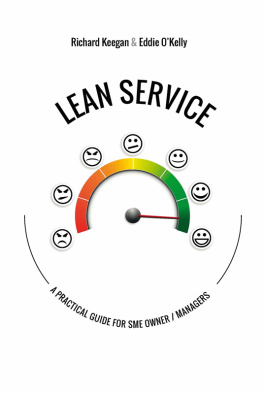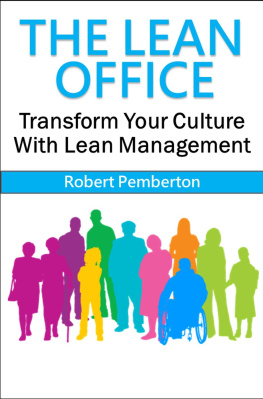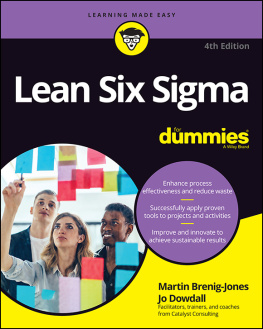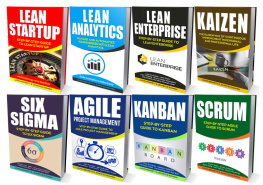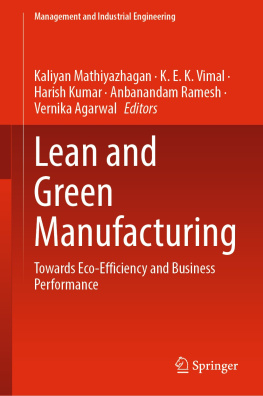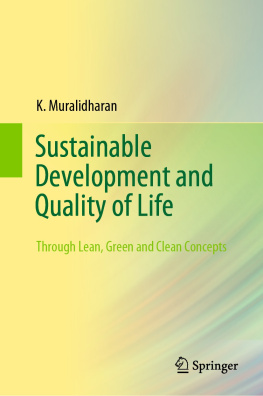LEAN
MANAGEMENT
The Essence of Efficiency
Road to Profitability
Power of Sustainability
Author KF CHONG
Co-authors Andrew Yong,
Chong Kim Loy

Copyright 2017 by KF Chong.
ISBN: Hardcover 978-1-5437-4276-3
Softcover 978-1-5437-4275-6
eBook 978-1-5437-4277-0
All rights reserved. No part of this book may be used or reproduced by any means, graphic, electronic, or mechanical, including photocopying, recording, taping or by any information storage retrieval system without the written permission of the author except in the case of brief quotations embodied in critical articles and reviews.
Because of the dynamic nature of the Internet, any web addresses or links contained in this book may have changed since publication and may no longer be valid. The views expressed in this work are solely those of the author and do not necessarily reflect the views of the publisher, and the publisher hereby disclaims any responsibility for them.
Toll Free 800 101 2657 (Singapore)
Toll Free 1 800 81 7340 (Malaysia)
www.partridgepublishing.com/singapore
CONTENTS
Unleashing the power of LEAN
For continuous improvement in Cost, Delivery & Quality
In
Manufacturing and Transactional process
Some insights this book may offer from the perspectives of LEAN...
Many people think that LEAN is all about cutting cost, slashing expenses or implementing austere measures. It isnt so... |
Some believe it is better to earn more than to save more. Some say a dollar saved is a dollar earned. We forget that we can do both. |
A principled organization stops to pass wastes into customers cost. |
LEAN management is a knowhow - more about being prudent than being austere. |
As we waste less, we earn more. LEAN always finds ways to do more with less by eliminating wastes systematically. |
Mass customization is becoming a norm... learn to deal with high mix low volume environment. |
To err is human - stop depending more on operators skill than it is humanly possible. |
In manufacturing; the good rule of thumb is that only the activities that can physically form and change the shape and character of the products or assemblies add value. In the service sector, only activities that appeal and are useful to customers add value. The rests are wastes. |
Quality is a top priority. It begins at the source level. It is built-in. |
Despite some advance techniques presented in this book, the LEAN contents are intended for a beginner to comprehend to start LEAN, and a veteran to contemplate for further enhancements. They are easy to read, thought provoking, and they challenge the conventional thinking.
T his book is unlike many others about LEAN management. It goes beyond theory to provide practical, real-life examples with case studies.
The author has 25 years work experience, including involvement in top management of multinational corporations as well as consultancy work. I have accumulated knowhow on what it takes to run an organization in an efficient and effective manner. I am truly grateful to have had such unique opportunities during my tenure to interact and work with top-level Presidents in Japanese company headquarters. I learnt a great deal from each and every one of them the different styles and approaches of management in delivering the bottom line. I concluded that no matter how different their approaches might be, one of the important concepts never strayed far from LEAN management. It is the reason why I choose this topic. You shall see it is quite different from other available LEAN book in the stores. My 25 years experience span conventional batch processing, to long conveyor production and highly sophisticated cellular systems. We focused on transformation in highly visible physical production, only to be overwhelmed by the underlying and invisible hour-by-hour changes in demand and supply, sudden part shortages, and sudden spikes in quality issues. In some instances, we started to implement LEAN projects, only for them to run adrift and realign, which were valuable learning experiences.
The company I worked in loves to implement job rotation in its quest to build multi-talents. Such a culture has provided me with great opportunity to learn great skills in both managing manufacturing and transactional departments.
What differentiates this book from others is that you will not only benefit from insight of LEAN knowhow in a practical manner. You will also witness wide range of collection of examples and case studies of important and successful LEAN implementations. Some of these may be adopted immediately to put in practice instead of starting from scratch. They may also give you inspirational new ideas that suit your unique environment. In addition, you will see how LEAN can be successfully applied in both manufacturing and transactional services. Besides being practical, this book is also presented in a conceptual manner, because not all LEAN implementations across the industries are the same. This requires managers to be passionate about the subjects if they are to be able to implement them.
This book will help you to understand that LEAN is a prudent and practical application rather than austere, and how low cost and high quality are not mutually exclusive terms.
Toyota, who pioneered the LEAN implementation through famous TPS (Toyota Production System), is the best example. Not only did Toyota become the worlds top automobile producer with its competitive prices, they also received the Deming Prize for good quality. It was reported that at its peak, Toyotas profits were greater than the combined profits of Ford, General Motors and Chrysler.
Since people involved in collecting and recycling wastes generate multi-millions dollar revenues each year, why not participate actively in waste elimination within our processes and organizations? More importantly, by going LEAN, we stop passing the costs of waste onto customers which is why LEAN is also a principled way of operation.
LEAN is always the essence to efficiency and effectiveness; whether you are in the red ocean or blue ocean business.
D uring good times, organizations often attest to the resilience on what is working. Key performance indexes such as revenue and profit are met. So why mess around with the success and fix something that is not broken? That is the usual response to proposals to implement improvement programs, LEAN programs included.
Slowly, this develops into a subconscious mentality of assuming whatever being done was of the best. There typically arent any mechanisms to question whether or not the approach we use is truly the best in class. Management may start to lose control of hiring, product lineups expand without good reasons, and processes become more and more complicated. Teams grow bigger resulting in an increase in levels of organizational hierarchy. More people are now involved in the decisions-making process. This phenomenon is similar to how households accrue stuffs during good time, which often include dust-keepers.
In such a bureaucracy, we find the recipe for disaster. When economic downturns hit, we start to see syndromes of last in first out and hiring and firing to perform the same actions at a faster pace and with fewer people, often at a cost of quality. Those companies which do this eventually run out of places to trim and streamline.
It need not be this way if companies were to adopt LEAN management effectively. LEAN addresses the fundamental strength of a company. LEAN management means a different mode of thinking and practice.
Next page
